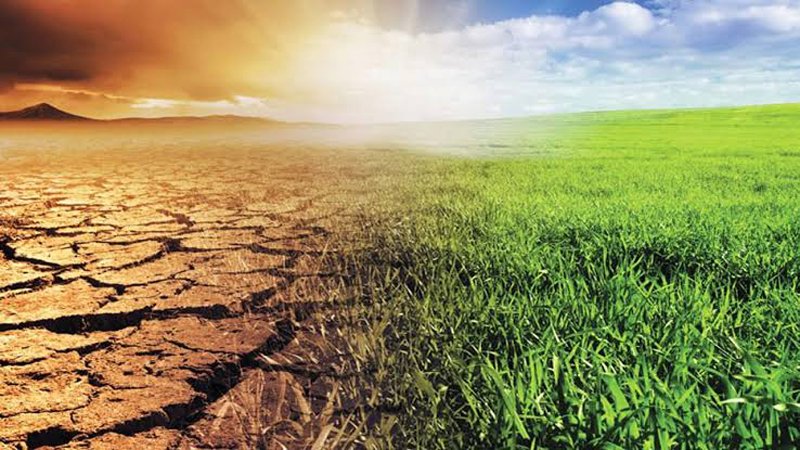Climate is the gradual increase in temperature and other changes in the Earth’s climate that are largely caused by human activities such as burning fossil fuels and deforestation.

Climate change can cause soil degradation, which can lead to lower crop yields. These impacts of climate change on Agriculture are not only affecting farmers but also consumers who depend on agriculture’s production.
Agriculture is the backbone of many economies, providing food, cloth, shelter, and other essential resources. However, agriculture is facing a new challenge under the name of climate change. The changing climate is causing droughts, floods, and other extreme weather patterns that can negatively impact agriculture production.
Climate is the gradual increase in temperature and other changes in the Earth’s climate that are largely caused by human activities such as burning fossil fuels and deforestation. Agriculture is an essential part of human civilization and has been practised for thousands of years.
The negative effects of climate change on Agriculture are expected to increase in the coming decades, especially in developing countries. The Intergovernmental Panel on Climate Change (IPCC) has projected that global warming will cause a decline in crop yield by 2% while demand for food will increase by 14% per decade. This will lead to a food shortage in the coming decade.
The changing climate is a big threat to all of humanity. Climate change is having a significant impact on agriculture, with changes in temperature, precipitation, and extreme weather patterns affecting crop yields and food production.
Some of the main effects of climate change on agriculture are:
-
Changing in temperature:
Rising temperatures can lead to more frequent heat waves and droughts, which can reduce crop yields and cause crop failures. Extreme heat can also cause damage to crops, reducing their quality and nutritional value.
-
Changing precipitation:
Changing precipitation patterns can lead to flooding or droughts, both of which can have a major impact on crop yield. Heavy rainfall can cause soil erosion and nutrient loss, while droughts can cause crops to wilt and die.
-
Pests and diseases:
Climate change can lead to the spread of pests and diseases that damage crops. Warmer temperatures can allow pests to survive and reproduce more easily, while changes in precipitation can create conditions that are more favourable for disease outbreaks.
-
Soil quality:
Changes in temperature and precipitation can also affect soil quality, reducing its fertility and nutrient content. This can make it more difficult to grow crops and reduce the overall productivity of agricultural systems.
Role of industries in climate change
Since the start of the industrial revolution in 1760, the Earth’s average temperature has risen faster than before.
Industries play a significant role in climate change. For example, the burning of fossil fuels in industrial processes releases carbon dioxide and other greenhouse gases into the atmosphere, which trap heat and contribute to global warming.
The manufacturing and transportation of products also generate emissions that contribute to climate change. In addition to the direct impact on the environment, climate change negatively affects human health, food supplies, and ecosystems.
Raising temperatures and changes in precipitation patterns lead to more frequent and severe heat waves, droughts, and floods, which can damage crops, cause food shortages, and increase the spread of disease. Climate change also threatens biodiversity, leading to the extinction of species and the loss of habitats.
Solution:
To mitigate these negative effects, industries can adopt more suitable practises, such as reducing energy sources and implementing waste reduction and recycling programmes.
The government can also regulate industrial emissions and incentivize suitable practises through policies and economic incentives. By taking action to reduce their impact on the environment, industries can help mitigate climate change and reduce its negative effects on human health and the planet.
Contribution of Agriculture to climate change:
Agriculture is the backbone of many countries, but agriculture also contributes to climate change through the adoption of several practises such as livestock farming, deforestation, and the use of fertilisers that release greenhouse gases into the atmosphere, which have negative impacts on the environment and cause climate change.
Livestock farming:
Livestock farming contributes to climate change through the production of cows and other animals. Methane is produced during the digestive processes of cows and other ruminants and is released into the atmosphere when they burp. Methane is a more potent greenhouse gas than carbon dioxide and is estimated to have a warming effect that is 28 times greater than carbon dioxide over a 100-year time scale.
Use of fertilisers:
Fertilisers can affect the climate by releasing nitrous oxide gas into the atmosphere. Nitrous oxide is released when bacteria into the soil breakdown nitrogen into fertiliser.
Solution:
There are some solutions that can reduce the impact of agriculture on climate change.
❖ Reduce deforestation by promoting sustainable forestry practises and reforestation.
❖ Reduce the numbers of cows and other ruminants in live stock farming and promote alternative protein sources such as plant-based proteins.
❖ Farmers can reduce the use of fertilisers by using organic farming practises, which can help improve soil health and reduce the need for synthetic fertilizers.
❖ Promote sustainable agriculture practises that reduce emissions, improve resilience to climate change, and increase food security.
Conclusion:
It is the responsibility of every human to reduce the use of those things that are leading to climate change, such as the burning of fossil fuels, deforestation, waste disposal, construction, and the use of fertilisers and electronics, which contribute to climate change by releasing greenhouse gases into the atmosphere.